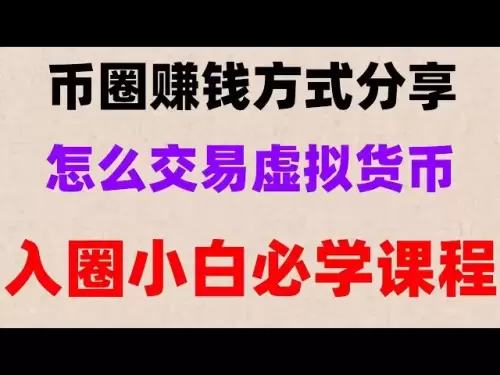-
 Bitcoin
Bitcoin $108,697.6224
-0.64% -
 Ethereum
Ethereum $2,543.9251
-0.33% -
 Tether USDt
Tether USDt $1.0000
-0.04% -
 XRP
XRP $2.2874
-2.29% -
 BNB
BNB $673.1816
0.31% -
 Solana
Solana $172.7222
-2.03% -
 USDC
USDC $0.9998
0.01% -
 Dogecoin
Dogecoin $0.2242
-0.73% -
 Cardano
Cardano $0.7523
-0.97% -
 TRON
TRON $0.2749
1.53% -
 Hyperliquid
Hyperliquid $36.8350
-4.98% -
 Sui
Sui $3.4681
-3.83% -
 Chainlink
Chainlink $15.4012
-1.34% -
 Avalanche
Avalanche $22.8746
-1.76% -
 Stellar
Stellar $0.2849
-0.70% -
 Shiba Inu
Shiba Inu $0.0...01440
-0.41% -
 Bitcoin Cash
Bitcoin Cash $412.6653
-2.48% -
 UNUS SED LEO
UNUS SED LEO $8.7956
-1.08% -
 Hedera
Hedera $0.1840
-2.44% -
 Monero
Monero $400.5140
-2.48% -
 Toncoin
Toncoin $2.9624
-0.56% -
 Litecoin
Litecoin $94.3131
-1.69% -
 Polkadot
Polkadot $4.4294
-2.25% -
 Bitget Token
Bitget Token $5.2568
-2.90% -
 Pepe
Pepe $0.0...01368
-0.09% -
 Pi
Pi $0.7542
-4.39% -
 Dai
Dai $0.9998
-0.01% -
 Ethena USDe
Ethena USDe $1.0006
-0.01% -
 Uniswap
Uniswap $6.3844
3.57% -
 Aave
Aave $264.4373
-2.07%
What should I do if the MACD top diverges and goes sideways? Does the lack of obvious decline mean that the divergence is invalid?
When MACD shows top divergence and price moves sideways, traders should monitor additional indicators and volume trends before making decisions.
May 25, 2025 at 11:15 pm
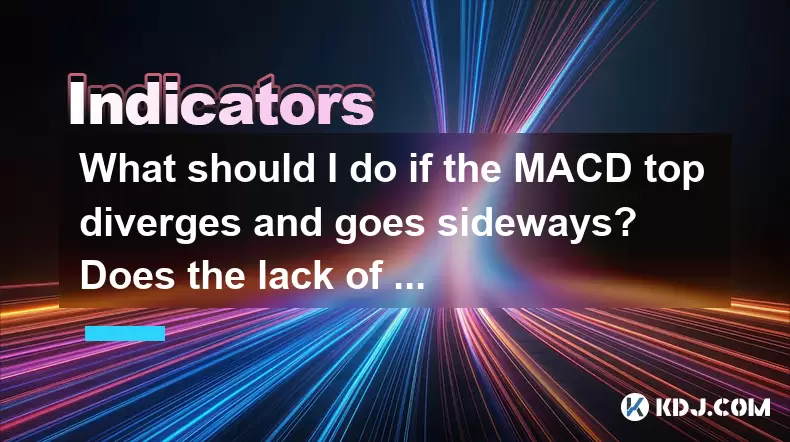
In the world of cryptocurrency trading, technical indicators like the Moving Average Convergence Divergence (MACD) play a crucial role in helping traders make informed decisions. One of the more complex scenarios traders encounter is when the MACD shows a top divergence and then moves sideways. This situation often raises questions about the validity of the divergence and what actions traders should take. Let's delve into this topic to understand the implications and the appropriate steps to take.
Understanding MACD Top Divergence
MACD top divergence occurs when the price of a cryptocurrency reaches a new high, but the MACD indicator fails to reach a corresponding new high. This discrepancy suggests that the bullish momentum is waning, potentially signaling an upcoming bearish reversal. Traders often view this as a warning sign to prepare for a possible price decline.
The Sideways Movement After Divergence
When the MACD top divergence is followed by a sideways movement in the price, it can be confusing. Sideways movement means that the price is not making significant highs or lows and is trading within a relatively narrow range. This can lead traders to question the validity of the initial divergence signal.
Analyzing the Lack of Obvious Decline
The lack of an obvious decline following a MACD top divergence does not necessarily invalidate the divergence. The absence of a clear downward move might indicate that the market is in a consolidation phase, where the forces of supply and demand are balanced, and no clear direction is established yet.
Interpreting the Situation
To properly interpret this situation, traders need to consider additional factors beyond just the MACD. Other technical indicators, such as the Relative Strength Index (RSI), Bollinger Bands, and volume, can provide further insights into the market's health and direction. For instance, if the RSI is also showing signs of divergence or if the volume is decreasing, it might reinforce the bearish signal from the MACD.
Steps to Take When MACD Top Divergence Goes Sideways
When faced with a MACD top divergence followed by a sideways movement, traders should follow a systematic approach to manage their positions effectively. Here are the steps to take:
Monitor Additional Indicators: Look at other technical indicators to confirm or refute the signals provided by the MACD. For example, if the RSI is also showing bearish divergence, it might strengthen the case for a potential downturn.
Watch Volume Trends: Pay attention to trading volume. A decrease in volume during the sideways movement might indicate that the bullish momentum is indeed fading, supporting the MACD divergence.
Set Clear Risk Management Rules: Establish stop-loss orders to protect against unexpected price movements. If the price breaks out of the sideways range to the upside, it might invalidate the bearish signal, and a stop-loss can help limit losses.
Look for Breakouts: Keep an eye on potential breakouts from the sideways range. A downward breakout could confirm the bearish divergence, while an upward breakout might suggest that the bullish trend is resuming.
Consider Timeframes: Analyze the situation across different timeframes. A divergence on a shorter timeframe might be less significant than one on a longer timeframe. Understanding the context can help in making more informed decisions.
Case Study: Bitcoin (BTC) and MACD Top Divergence
Let's consider a hypothetical scenario with Bitcoin (BTC) to illustrate how to handle a MACD top divergence that moves sideways. Suppose BTC reaches a new high at $50,000, but the MACD fails to reach a new high, indicating a top divergence. Following this, BTC enters a sideways range between $48,000 and $50,000.
Monitor Additional Indicators: The RSI on the daily chart shows a similar divergence, and the volume has been decreasing over the past few days, supporting the bearish signal from the MACD.
Watch Volume Trends: The volume remains low during the sideways movement, suggesting that the bullish momentum is indeed fading.
Set Clear Risk Management Rules: A trader might set a stop-loss order just above $50,000 to protect against a potential breakout to the upside.
Look for Breakouts: The trader keeps a close watch on the price action. If BTC breaks below $48,000, it could confirm the bearish divergence, and the trader might consider shorting the asset or exiting long positions.
Consider Timeframes: The trader also checks the weekly chart and finds that the divergence is visible on this longer timeframe, adding more weight to the bearish signal.
Practical Application in Trading
In practice, traders need to be patient and disciplined when dealing with a MACD top divergence followed by a sideways movement. It's essential not to rush into decisions based solely on the MACD signal. Instead, use a combination of indicators and market analysis to make well-informed trades.
Using Other Technical Analysis Tools
In addition to the MACD, other technical analysis tools can be invaluable in confirming or refuting the signals from a top divergence. Fibonacci retracement levels can help identify potential support and resistance levels within the sideways range. Candlestick patterns such as dojis, hammers, or shooting stars can provide additional clues about potential reversals or continuations.
The Role of Market Sentiment
Market sentiment also plays a crucial role in interpreting the implications of a MACD top divergence that moves sideways. If the broader market sentiment remains bullish, the sideways movement might be seen as a consolidation before another upward move. Conversely, if sentiment is turning bearish, the sideways movement could be a precursor to a more significant decline.
Frequently Asked Questions
Q: How long should I wait for a confirmation of a MACD top divergence that goes sideways?
A: The duration can vary depending on the specific market conditions and the timeframe you are trading on. Generally, it's advisable to wait for at least a few days to a week on a daily chart to see if the price breaks out of the sideways range. Patience is key, as rushing into decisions can lead to unnecessary losses.
Q: Can a MACD top divergence followed by a sideways movement be a false signal?
A: Yes, it can be a false signal. If the price eventually breaks out to the upside, it might indicate that the bullish trend is resuming, and the initial divergence was a false signal. Always use multiple indicators and market analysis to confirm the validity of any signal.
Q: Should I enter a short position immediately after seeing a MACD top divergence that goes sideways?
A: No, it's not advisable to enter a short position immediately. Wait for additional confirmation from other indicators and watch for a potential downward breakout from the sideways range. Entering a trade prematurely can lead to losses if the market moves against your position.
Q: How can I differentiate between a consolidation phase and a potential reversal after a MACD top divergence?
A: Differentiating between consolidation and reversal requires a careful analysis of multiple factors. Look for signs of decreasing volume during the sideways movement, which might indicate a loss of bullish momentum. Also, check for other bearish signals from indicators like the RSI or Bollinger Bands. A clear breakout below the sideways range can confirm a reversal.
Disclaimer:info@kdj.com
The information provided is not trading advice. kdj.com does not assume any responsibility for any investments made based on the information provided in this article. Cryptocurrencies are highly volatile and it is highly recommended that you invest with caution after thorough research!
If you believe that the content used on this website infringes your copyright, please contact us immediately (info@kdj.com) and we will delete it promptly.
- Miningcoop launches an AI-powered cloud mining platform with up to $100 free credits
- 2025-05-27 11:05:14
- Alchemy Pay Integrates PayID to Deliver Seamless Crypto Payments in Australia
- 2025-05-27 11:05:14
- Crypto assets to the tune of over $3 billion are heading into circulation in June
- 2025-05-27 11:00:27
- ERC-20 is the Most Widely Used Token Standard on Ethereum. Here's What It Means.
- 2025-05-27 11:00:27
- Bitlayer, a Bitcoin Layer 2 built on the BitVM paradigm, has partnered with three of the world's largest bitcoin
- 2025-05-27 10:55:14
- XRP Navigates Complex Market Landscape Amidst Significant Capital Inflows and Waning Network Activity
- 2025-05-27 10:55:14
Related knowledge
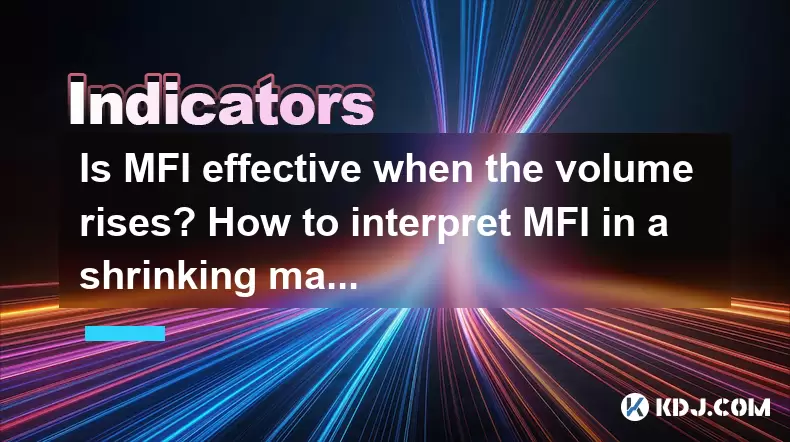
Is MFI effective when the volume rises? How to interpret MFI in a shrinking market?
May 27,2025 at 02:42am
The Money Flow Index (MFI) is a momentum indicator that measures the inflow and outflow of money into a security over a specific period. It is particularly useful in identifying overbought or oversold conditions in the market. In this article, we will explore the effectiveness of MFI when volume rises and how to interpret MFI in a shrinking market. Unde...
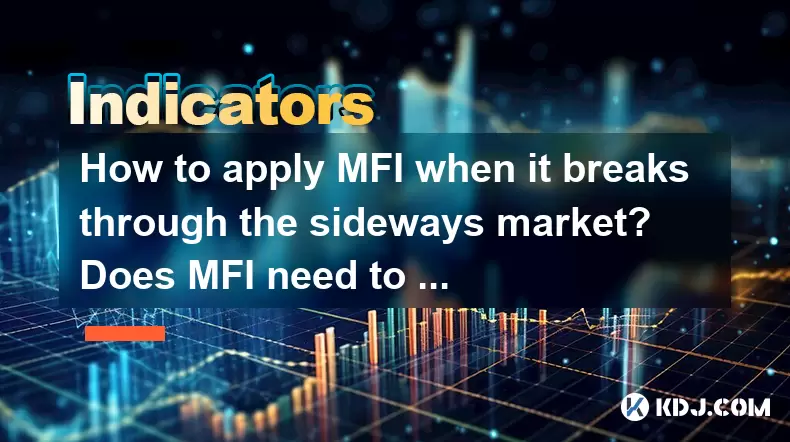
How to apply MFI when it breaks through the sideways market? Does MFI need to be combined with other indicators when it breaks through?
May 27,2025 at 09:08am
The Money Flow Index (MFI) is a momentum indicator that measures the inflow and outflow of money into a security over a specific period. When the MFI breaks through a sideways market, it can signal potential shifts in market sentiment and trading opportunities. Understanding how to apply MFI in such scenarios and whether it should be combined with other...
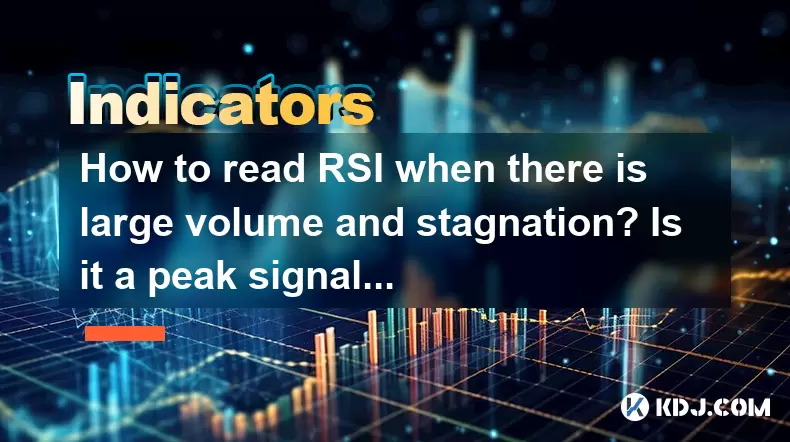
How to read RSI when there is large volume and stagnation? Is it a peak signal?
May 27,2025 at 03:28am
Understanding RSI and Volume in Cryptocurrency TradingThe Relative Strength Index (RSI) is a momentum oscillator that measures the speed and change of price movements. It is widely used by traders to identify overbought or oversold conditions in the market. When combined with volume, which indicates the number of shares or contracts traded in a security...
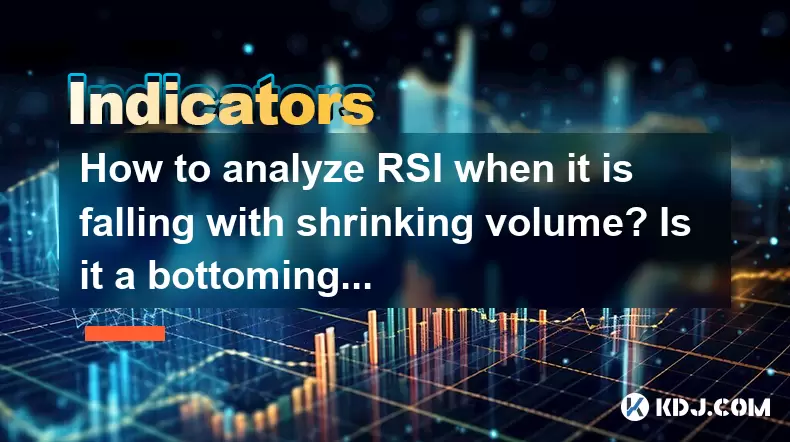
How to analyze RSI when it is falling with shrinking volume? Is it a bottoming signal?
May 27,2025 at 03:35am
Analyzing the Relative Strength Index (RSI) in conjunction with volume can provide valuable insights into potential market movements, particularly when considering whether a security is approaching a bottom. When the RSI is falling and volume is shrinking, it's important to understand the context and implications of these indicators to determine if it m...
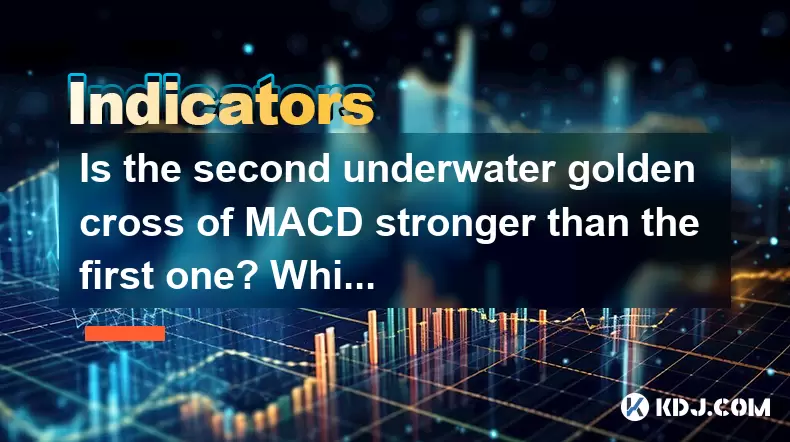
Is the second underwater golden cross of MACD stronger than the first one? Which pattern is the most reliable in an oversold rebound?
May 27,2025 at 03:14am
The Moving Average Convergence Divergence (MACD) indicator is a popular tool among cryptocurrency traders for identifying potential trend changes and momentum shifts. One of the key signals that traders look for is the golden cross, which occurs when the MACD line crosses above the signal line. When this happens underwater, or below the zero line, it is...
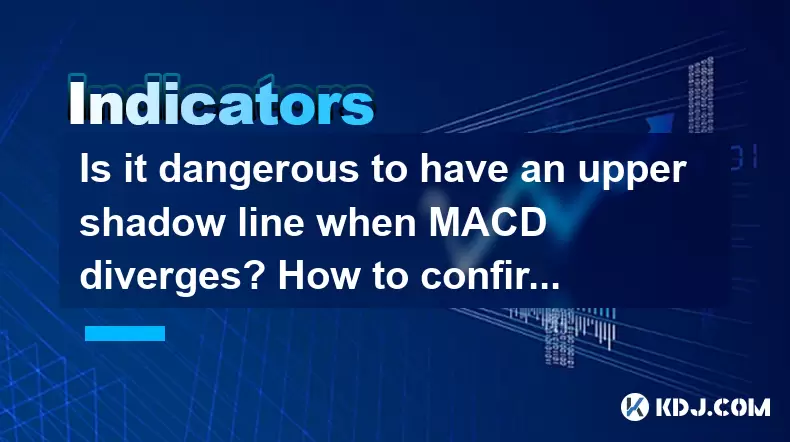
Is it dangerous to have an upper shadow line when MACD diverges? How to confirm the top through the K-line pattern?
May 27,2025 at 12:21am
Understanding MACD Divergence and Upper Shadow LinesWhen it comes to technical analysis in the cryptocurrency market, the Moving Average Convergence Divergence (MACD) indicator and candlestick patterns such as upper shadow lines are crucial tools for traders. MACD divergence occurs when the price action of a cryptocurrency diverges from the MACD indicat...

Is MFI effective when the volume rises? How to interpret MFI in a shrinking market?
May 27,2025 at 02:42am
The Money Flow Index (MFI) is a momentum indicator that measures the inflow and outflow of money into a security over a specific period. It is particularly useful in identifying overbought or oversold conditions in the market. In this article, we will explore the effectiveness of MFI when volume rises and how to interpret MFI in a shrinking market. Unde...

How to apply MFI when it breaks through the sideways market? Does MFI need to be combined with other indicators when it breaks through?
May 27,2025 at 09:08am
The Money Flow Index (MFI) is a momentum indicator that measures the inflow and outflow of money into a security over a specific period. When the MFI breaks through a sideways market, it can signal potential shifts in market sentiment and trading opportunities. Understanding how to apply MFI in such scenarios and whether it should be combined with other...

How to read RSI when there is large volume and stagnation? Is it a peak signal?
May 27,2025 at 03:28am
Understanding RSI and Volume in Cryptocurrency TradingThe Relative Strength Index (RSI) is a momentum oscillator that measures the speed and change of price movements. It is widely used by traders to identify overbought or oversold conditions in the market. When combined with volume, which indicates the number of shares or contracts traded in a security...

How to analyze RSI when it is falling with shrinking volume? Is it a bottoming signal?
May 27,2025 at 03:35am
Analyzing the Relative Strength Index (RSI) in conjunction with volume can provide valuable insights into potential market movements, particularly when considering whether a security is approaching a bottom. When the RSI is falling and volume is shrinking, it's important to understand the context and implications of these indicators to determine if it m...

Is the second underwater golden cross of MACD stronger than the first one? Which pattern is the most reliable in an oversold rebound?
May 27,2025 at 03:14am
The Moving Average Convergence Divergence (MACD) indicator is a popular tool among cryptocurrency traders for identifying potential trend changes and momentum shifts. One of the key signals that traders look for is the golden cross, which occurs when the MACD line crosses above the signal line. When this happens underwater, or below the zero line, it is...

Is it dangerous to have an upper shadow line when MACD diverges? How to confirm the top through the K-line pattern?
May 27,2025 at 12:21am
Understanding MACD Divergence and Upper Shadow LinesWhen it comes to technical analysis in the cryptocurrency market, the Moving Average Convergence Divergence (MACD) indicator and candlestick patterns such as upper shadow lines are crucial tools for traders. MACD divergence occurs when the price action of a cryptocurrency diverges from the MACD indicat...
See all articles





















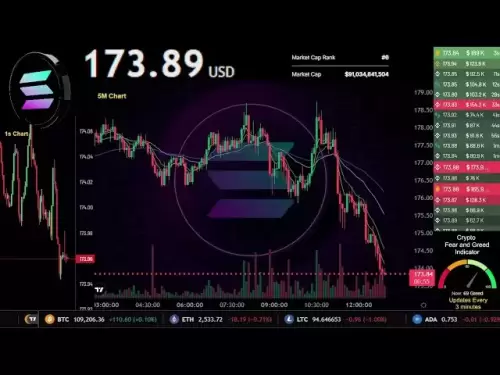


![[USDT Gray Product Project] Virtual currency bricks are used to make money by using part-time spare time, the fastest way to make money online in 2025! Earn thousands of dollars a day, black U whitewashing tutorial, [Black Violence Project 2025] usdt Viol [USDT Gray Product Project] Virtual currency bricks are used to make money by using part-time spare time, the fastest way to make money online in 2025! Earn thousands of dollars a day, black U whitewashing tutorial, [Black Violence Project 2025] usdt Viol](/uploads/2025/05/27/cryptocurrencies-news/videos/usdt-gray-product-project-virtual-currency-bricks-money-time-spare-time-fastest-money-online-earn-thousands-dollars-day-black-whitewashing-tutorial-black-violence-project-usdt-violence-gray-project-complete-basic-cryptocurrency-transaction-tutorial/68349e5072a99_image_500_375.webp)
